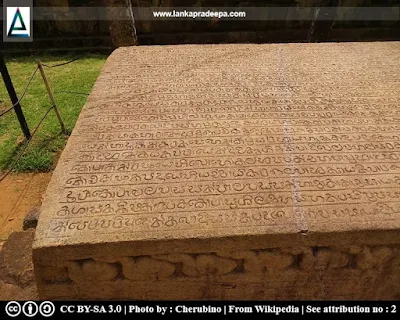
|
Gal Potha Stone Inscription |
Gal Potha (lit: Stone book; Sinhala: ගල්පොත සෙල්ලිපිය) is a giant stone slab inscription in the Ancient City of Polonnaruwa, Sri Lanka. It has been established between the eastern outer wall of the Hetadage and Satmahal Prasada.

This inscription is a work of King Nissankamalla (1187-1196 A.D.) of Polonnaruwa and is the longest inscription indited by him. It is about 26 ft. 8 in. in length, 4 ft. 7 in. in breadth, and 1 ft. 9 in. (average) in-depth making the inscription one of the largest stone inscriptions so far discovered. The writing is on the smoothed upper surface of the slab and has been divided into three partitions. The letters are well preserved in the first two portions but in the third many of them have been so worn off (Ranawella, 2007). The total number of lines it has are seventy-two, containing more than 4,300 letters (Ranawella, 2007; Wickremasinghe, 1928). Indications show that the inscription had been raised on a brick podium underpinned with short pillars (the weight of the rock slab is approximately 15 tons) and sheltered by a canopy supported by ten stone pillars, 5 ft. in height above floor level (Ranawella, 2007). Two or three letters at the very end of the inscription had inlay indicating that the whole inscription would have been gilded with molten iron (Fernando, 1990).
Both end sides of the stone are decorated with a woman holding flowers to whom a pair of elephants are sprinkling water. This figure has been identified as Gajalakshmi, the Goddess of prosperity. Two lines of Hamsas (goose) decorate both sides and ends of the slab. The inscription itself says that this large granite block was transported from Segiriya (present Mihintale in Anuradhapura - located about 70 km from Polonnaruwa) by the strong men of King Nissankamalla under the leadership of Adhikara Totadanavu Mand-navan (Ranawella, 2007; Wickremasinghe, 1928). However it is suggested by some scholars, such as Muller and also Wickremasinghe, that the original location of this slab may not be the Segiriya but Sigiriya which is about 28 km far from Polonnaruwa (Wickremasinghe, 1928).
The inscription doesn't bear a date, but from the information it has given, scholars have dated it to the ninth year of the reign of King Nissankamalla (Wickremasinghe, 1928). It outlines the genealogy, some policies, duties, responsibilities, and altruistic deeds of the king.

Galpota slab inscription of Nissankamalla
Reign: Nissankamalla (1187-1196 A.D.)
Period: 12th century A.D.
Language: Medieval Sinhala mixed with Sanskrit
Script: Medieval Sinhala
Transcript: Sri Dhrmas soyam sarbba lok-aika-manyas-sreyo-dayi sarbba-da raksaniyah bhupalendran yacate kirtti .....>>
Translation: Hail! This Dharma, which gives happiness and which alone deserves to be honoured by the whole world......>>
Citation: Wickremasinghe, 1928

|
Gal Potha Stone Inscription |
Related Posts
Read Also
References
Books, Journal Articles
1) Fernando, W.B.M., 1990. History of the Department of Archaeology, Sri Lanka 1930-1950. Wijesekara, N. (Editor in chief). Archaeological Department centenary (1890-1990): Commemorative series: Volume I: History of the Department of Archaeology. Department of Archaeology (Sri Lanka). p.101.
2) Ranawella, S., 2007. Inscription of Ceylon. Volume VI. Department of Archaeology. ISBN: 978-955-91-59-61-2. pp.53-65.
3) Wickremasinghe, D. M. D. Z., 1928. Epigraphia Zeylanica: Being lithic and other inscriptions of Ceylon (Vol, II). Published for the government of Ceylon by Humphrey Milford. pp.98-123.
Location Map
Dynamic Google Map
Attribution
To Whom
1) Gal Potha 03 by Cherubino is licensed under CC BY-SA 3.0
2) Gal Potha 05 by Cherubino is licensed under CC BY-SA 3.0
ගල්පොත ශිලා ලේඛනය
ගල්පොත යනුවෙන් හඳුන්වනු ලබන දැවැන්ත ශිලාමය පුවරු ලිපිය ශ්රී ලංකාවේ පොළොන්නරුව පුරාණ නගරයෙහි හැටදාගෙය නැගෙනහිර පිටත පවුර සහ සත්මහල් ප්රාසාදය අතර දැකගත හැකිවේ.
පොළොන්නරුව නිශ්ශංකමල්ල රජු (ක්රි.ව. 1187-1196) විසින් කරවනු ලැබූ දීර්ඝතම ශිලා ලේඛනය මෙය ලෙස සැළකේ. දිග අඩි 26යි අඟල් 8ක් හා පළල අඩි 4 යි අඟල් 7 ක් (සාමාන්යය) වන සෙල්ලිපිය මෙතෙක් සොයාගෙන තිබෙන විශාලතම ශිලා ලේඛන අතුරින් එකකි. පුවරුවෙහි සුමට කරන ලද ඉහළ මුහුණතෙහි කොටවා ඇති සෙල්ලිපිය කොටස් 3කට බෙදා තිබේ. පේලි 72 කින් සමන්විත වන මෙහි අක්ෂර 4,300 කට වඩා වැඩි ප්රමාණයක් ඇත. ශිලා ලේඛනය සහිත ගල් පුවරුව ගඩොල් වේදිකාවක් මත රඳවා තිබූ බවටත් එහි ආරක්ෂාවට පියස්සක් තිබූ බවටත් සාධක පවතී. මෙහි ඇති අකුරු සඳහා ලෝහමය දියරයක් පුරවා තිබෙන්නට ඇතැයි විශ්වාස කෙරේ.
ශිලා පුවරුවෙහි දෙකෙලවර පැති මුහුණත් දෙකෙහි ඇතුන් දෙදෙනෙකු විසින් පිරිවරන ලද පුෂ්ප දරාසිටින කාන්තා රුවක් දැකගත හැකිවන අතර ඇය ගජලක්ෂ්මී දෙවඟන ලෙස හඳුනාගැනේ. සෙල්ලිපියෙහි දක්වා ඇති ආකාරයට මෙම දැවැන්ත ගල් කුට්ටිය සෑගිරියේ (වත්මන් මිහින්තලේ - පොළාන්නරුව සිට කි.මී. 70 ක් පමණ දුරින් පිහිටි) සිට ගෙනැවිත් තිබෙනුයේ අධිකාර තොටදනවු මන්ද්නාවන් ප්රමුඛ නිශ්ශංකමල්ල රජුගේ ශක්තිමත් පුරුෂයන් විසිනි. කෙසේනමුදු, මුලර් හා වික්රමසිංහ වැනි වියතුන්ගේ මතය අනූව මෙම දැවැන්ත ගල් කුට්ටිය මෙහි ගෙන එන්නට ඇත්තේ සෑගිරිය සිට නොව සීගිරිය (පොළාන්නරුව සිට කි.මී. 28 ක් පමණ දුරින් පිහිටි) සිට විය හැකිය.
ශිලා ලේඛනයෙහි දිනයක් සඳහන් නොවූවද එහි අන්තර්ගත කරුණු අනූව වියතුන් විසින් මෙම සෙල්ලිපිය නිශ්ශංකමල්ල රජුගේ නවවන රාජ්ය වර්ෂයට අයත් යැයි අදහස් දක්වා ඇත. නිශ්ශංකමල්ල රජුගේ පරපුර, වීරක්රියා, වගකීම්, හා පුණ්ය ක්රියා ආදිය මෙම සෙල්ලිපියෙහි විස්තර කෙරේ.

